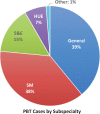Trends in the Treatment of Biceps Pathology: An Analysis of the American Board of Orthopaedic Surgery Database
- PMID: 33447620
- PMCID: PMC7780327
- DOI: 10.1177/2325967120969414
Trends in the Treatment of Biceps Pathology: An Analysis of the American Board of Orthopaedic Surgery Database
Abstract
Background: Long head of biceps tendon pathology is a well-described source of pain in the anterior adult shoulder. Shoulder arthroscopic surgeons face this condition on a frequent basis because of the increasing aging population. Trends in treatment for this condition have varied over recent decades. An understanding of these trends may help orthopaedic surgeons counsel these patients.
Purpose: To evaluate trends in treatment selection, patient population, and complications in recent part II examinees of the American Board of Orthopaedic Surgery (ABOS) board examination.
Study design: Cross-sectional study.
Methods: Using a database maintained by the ABOS, we accessed and analyzed examinee data from 2008 to 2019 to evaluate trends in the following categories: examination year/subspecialty, region, patient age/sex, International Classification of Diseases code, Current Procedural Terminology code, and complications. These data points were analyzed for all board-eligible candidates from 2008 to 2019.
Results: The annual number of proximal biceps tendon (PBT) procedures performed increased significantly from 597 cases in 2008 to 2203 cases in 2019 (P < .001). Incidence of biceps tendon tenotomy significantly decreased between the years 2007 and 2018 (P < .001). Both open and arthroscopic biceps tenodesis significantly increased between 2007 and 2018 (P < .001). Most PBT cases were performed simultaneously with other procedures (17,283/17,861; 96.8%). The most common PBT procedure performed overall was open tenodesis of long tendon of biceps (∼60.8%). Complication rates for PBT procedures reported each year did not significantly change between 2007 and 2018 (7.5% vs 9.7%; P = .103).
Conclusion: PBT procedures are being increasingly performed among recently trained orthopaedic surgeons. Proximal biceps tenotomy has significantly declined, whereas proximal biceps tenodesis, open or arthroscopic, has significantly increased, demonstrating a possible shift in the standard of care among new surgeons.
Keywords: arthroscopy; biceps tendon; biceps tenodesis; biceps tenotomy.
© The Author(s) 2020.
Conflict of interest statement
One or more of the authors has declared the following potential conflict of interest or source of funding: S.D.J. has received educational support from Gemini Mountain Medical. S.G.T. has received educational support from Quest Medical. R.M.F. has received grant support from Arthrex, educational support from Arthrex/Medwest and Smith & Nephew, speaking fees from Arthrex, and royalties from Elsevier. AOSSM checks author disclosures against the Open Payments Database (OPD). AOSSM has not conducted an independent investigation on the OPD and disclaims any liability or responsibility relating thereto.
Figures



References
-
- Ahmad CS, DiSipio C, Lester J, Gardner TR, Levine WN, Bigliani LU. Factors affecting dropped biceps deformity after tenotomy of the long head of the biceps tendon. Arthroscopy. 2007;23(5):537–541. - PubMed
-
- Boileau P, Baque F, Valerio L, Ahrens PM, Chuinard C, Trojani C. Isolated arthroscopic biceps tenotomy or tenodesis improves symptoms in patients with massive irreparable rotator cuff tears. J Bone Joint Surg Am. 2007;89(4):747–757. - PubMed
-
- Frank RM, Cotter EJ, Hannon CP, Harrast JJ, Cole BJ. Cartilage restoration surgery: incidence rates, complications, and trends as reported by the American Board of Orthopaedic Surgery part II candidates. Arthroscopy. 2019;35(1):171–178. - PubMed
LinkOut - more resources
Full Text Sources

